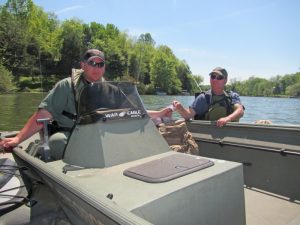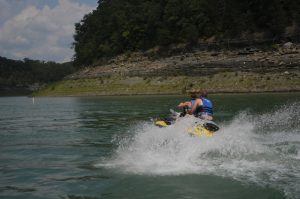
Photo: Kentucky Department Fish and Wildlife
The sun sets earlier each day and the kids are back in school. Summer is all but over. This inevitability prompts many to visit lakes, rivers and streams to get in that last weekend of the summer boating season during the Labor Day holiday weekend.
“Our busiest weekend of the year,” said Maj. Shane Carrier, assistant director of law enforcement for the Kentucky Department of Fish and Wildlife Resources. “Traditionally, Labor Day marks the end of the boating season.”
The crowded conditions common on this holiday weekend make observance of simple boating safety procedures vital to a safe weekend for everyone.
The law requires each passenger in a vessel to have a personal floatation device, commonly called a lifejacket, readily accessible for use. “I cannot stress enough the importance of wearing a lifejacket,” Carrier said. He explained that a lifejacket stored in a compartment or stuffed under a seat is not readily accessible.
“You must be able to get to the lifejacket quickly when you need it,” Carrier said.
Sales of paddlecraft such as kayaks, canoes and stand up paddleboards are booming, but wearing a lifejacket while paddling is of paramount importance for safety.
“Paddlecraft use is growing by leaps and bounds across Kentucky,” Carrier said. “Many paddlecraft users overlook the safety aspect. Paddlecraft are slow and do not have a motor. This lulls people into a false sense of security. I strongly suggest wearing a lifejacket at all times when operating a paddlecraft.”
Carrier said he sees many stand up paddleboard operators with their lifejacket strapped to the front of the paddleboard. “That doesn’t work well if you fall over and hit your head,” he said.
Paddlecraft now line the front of sporting goods, department and hardware stores awaiting a buyer.
“People buy paddlecraft with no training or experience and get in over their head, especially in moving water,” Carrier said. “Leave a float plan with a loved one and get a dry bag to store a charged cell phone on your boat in case you get in trouble.”
Carrier said the law enforcement division spent many hours this year on search and rescue efforts to look for paddlers. “We’ve had quite a few misjudge their take out or how long it takes to paddle there,” he said. “They must know how long it takes to get the float completed. If there is low water and you have to drag a boat over riffles and shoals, it takes time.”
Avoiding alcoholic drinks is one of the smartest safety decisions boaters can make. “Drinking in public is against the law in Kentucky and our waterways are public places,” Carrier said.
The combination of hours in the sun, heat and movement of the boat can induce a mild stupor called boater’s fatigue. “Alcohol intensifies boater’s fatigue,” Carrier said. “This condition can lead to poor decisions on the water.”
Carrier stressed the importance of checking safety equipment to ensure it is in good working order.
A boat with a motor must have a working fire extinguisher on board at all times. “Store the fire extinguisher away from the engine,” Carrier said. “On some boats with inboard-outboard motors, the fire extinguisher is mounted in the engine compartment. If you have a fire, you will burn yourself trying to get to it.”
All vessels over 16 feet in length must have a hand, mouth or power-operated signaling device such as a loud whistle or boat horn. They must also have working red and green navigation lights in the bow of the vessel and a steady white light visible from 360 degrees in the stern.
Boat operators must display these lights from sunset to sunrise in areas where other boats navigate, whether the boat is under power or anchored.
Some boaters mistakenly believe you do not need working navigation lights if you only operate the boat during daylight hours. Mechanical failures, dead batteries or getting lost can prevent a boat from getting back to the dock or ramp before nightfall when you must display these lights. Therefore, lights must be in working condition no matter when you operate the boat.
“You need a light at night so you don’t get run over by another boat,” Carrier said.
Each vessel must have a Type IV throwable personal floatation device such as a float cushion or ring readily accessible for use.
“Although this isn’t boating related, we’ve had multiple people this year drown from swimming,” Carrier said. “People, especially teenagers, try to swim beyond their ability and misjudge the distance. Peer pressure can induce them to try to swim across a large cove and then it is too late.”
Obey these simple safeguards and make the Labor Day weekend memorable for the right reasons.

Photo: Kentucky Department Fish and Wildlife
Kentucky’s lakes and streams are bound to be crowded with anglers, paddlers and pleasure boaters during the upcoming Memorial Day holiday weekend.
Boating safety officials want everyone to have a safe and enjoyable experience on the water.
“On really busy holidays, the boat’s operator has to remain extremely attentive,” said Zac Campbell, boating education coordinator for the Kentucky Department of Fish and Wildlife Resources. “They need to go slower than they normally would, and they should be wearing a life jacket at all times, but especially while they are underway, day or night.”
Recreational boating statistics compiled annually by the U.S. Coast Guard show an overwhelming percentage of people who had been involved in boating accidents and drowned were not wearing a life jacket at the time.
Federal and state law require a Type I, II or III life jacket for each person on board a vessel. Anyone operating or riding on a personal watercraft must wear an approved life jacket. Children under 12 are required to wear an approved life jacket any time they’re in an open portion of a boat that’s underway. Boaters ages 12 and older aren’t required to wear a life jacket, but there should a readily accessible one for every person on board.
“If a person can’t swim, they really need to have a life jacket on at all times,” Campbell said. “People who are strong swimmers should try this test: dive in the lake then have someone throw them a vest. Now try to put it on – it’s difficult to do once you’re in the water.”
Operators should have passengers try on their life jackets beforehand to familiarize themselves with how they work and make any necessary adjustments.
A person must be 12 years or older to operate a motorboat or personal watercraft in Kentucky. To drive a motorboat or personal watercraft powered by a 10 horsepower or greater motor, children ages 12-17 years old will need either a Kentucky Safe Boating Certificate Card or a certificate showing successful completion of a National Association of State Boating Law Administrators (NASBLA)-approved boater education course.
A boater education course benefits novice and experienced boaters alike. Courses are offered in person around the state at no charge and online for a fee. Course schedules are posted on Kentucky Fish and Wildlife’s website at fw.ky.gov. Registration is required.
Visitors to the department’s boater education web page can find links to the online courses as well as a boating safety checklist.
Nobody wants to get to the launch ramp only to realize they forgot to renew their boat registration, or they don’t have enough life jackets or a throwable cushion, or they forgot to charge their boat batteries.
“For a lot of people, Memorial Day weekend is the first time their boat’s been on the water this year,” Campbell said. “Ideally, you should take your boat out on a smaller body of water to test everything out before the big weekend to make sure it’s mechanically sound.”
Either way, you will want to have your boat numbers and decals properly displayed. Slide the registration receipt into a sealable sandwich bag and stow it on board. If the boat has an engine, lantern, stove or other equipment fueled by a flammable liquid, you will need to have a fire extinguisher. A horn or a whistle is required for boats 16 feet or longer, but good to carry in smaller boats. Test the red, green and 360-degree white navigation lights to ensure they are in working order. One small thing that is easy to overlook is securing the boat’s plug. Always double check that it is in place before launching.
When lake and river levels are up, as they have been in recent weeks across Kentucky, boaters must also be on the lookout for floating debris and keep in mind that some hazards may be hidden just below the surface.
“The water might not be as clear when the water is up, so objects that aren’t normally submerged can be even harder to spot,” Campbell said. “The operator is in charge of everybody’s well-being on the boat, but a good operator will have a good spotter who can help identify any hazards.”
A log striking a lower unit can throw occupants overboard and capsize a boat. An ignition kill switch combined with wearing a life jacket can be a godsend in such an event.
Most boats are equipped with a flexible red cord or lanyard that attaches to the ignition or throttle and clips to the boat operator’s life jacket or is worn around the wrist. Should the operator be ejected from the boat, the kill switch trips and stops the engine. If your boat’s lanyard or cord is missing, replacements are available through retailers that sell boating equipment.
The Memorial Day holiday weekend revs up the summer boating season and is one of the busiest boating weekends of the year. Make it a safe one by preparing ahead of time and operating responsibly while on the water.

Photo From KY Transportation Cabinet
The arrival of Memorial Day weekend signals the start of boating season at lakes and marinas across Kentucky.
The Kentucky State Parks and the Kentucky Department of Housing, Buildings and Construction want your boating experience with your family to be a safe one. This May – National Electrical Safety Month — the two agencies want to alert boaters to the dangers of “electric shock drowning.”
Electric shock drowning occurs when faulty wiring, equipment or damaged cords on a boat or dock cause surrounding water to be energized with an electric current. There is no visible warning and the electricity is enough to paralyze the muscles of a nearby swimmer, causing them to drown. In some cases, there may be enough current to electrocute the swimmer.
Here are some tips to prevent electric shock drowning:
- Never swim in the water at marinas. Boats often plug into electric pedestals at the marina for power.
- Make sure all electrical devices on your boat are working properly. If you suspect a problem, contact a certified electrical inspector immediately. To locate a certified electrical inspector near you, visit https://ky.joportal.com/License/Search
- If you suspect an electric shock drowning is taking place, turn off the power, throw a life ring to the victim and call 911. Do not jump in the water – you could become a victim.
Kevin Ritz, whose son Lucas was electrocuted while swimming near a dock in 1999, has worked to raise awareness of electric shock drowning. He said the first step for parents is to avoid the danger.
“Let’s not swim in and around marinas,” Ritz said. Boat owners and marina operators also need to be aware of the issue and take the proper precautions. Ritz founded the Electric Shock Drowning Prevention Association and has worked with the American Boat & Yacht Council.
For information about boat and electric safety, visit these sites: www.electricshockdrowning.org; www.abycinc.org
To learn more about the Department of Housing, Buildings & Construction, visit http://dhbc.ky.gov/. For more information about Kentucky State Parks and marinas, visit www.parks.ky.gov
 Weather
Weather Traffic
Traffic @LouisvilleDispatch
@LouisvilleDispatch @LouisvilleDisp
@LouisvilleDisp Subscribe
Subscribe
